The Optimization of Cold Rubidium Atom Two-Photon Transition Excitation with an Erbium-Fiber Optical Frequency Comb
Abstract
1. Introduction
2. Principle
3. Experiment & Results
4. Conclusions
Author Contributions
Funding
Conflicts of Interest
References
- Young, B.C.; Cruz, F.C.; Itano, W.M.; Bergquist, J.C. Visible lasers with subhertz linewidths. Phys. Rev. Lett 1999, 82, 3799–3802. [Google Scholar] [CrossRef]
- Argence, B.; Chanteau, B.; Lopez, O.; Nicolodi, D.; Abgrall, M.; Chardonnet, C.; Daussy, C.; Darquié, B.; Le Coq, Y.; Amy-Klein, A. Quantum cascade laser frequency stabilization at the sub-hz level. Nat. Photonics 2015, 9, 1079–1083. [Google Scholar] [CrossRef]
- Jiang, Y.Y.; Ludlow, A.D.; Lemke, N.D.; Fox, R.W.; Sherman, J.A.; Ma, L.S.; Oates, C.W. Making optical atomic clocks more stable with 10−16-level laser stabilization. Nat. Photonics 2011, 5, 158–161. [Google Scholar] [CrossRef]
- Takamoto, M.; Katori, H. An optical lattice clock. Nature 2005, 435, 321–324. [Google Scholar] [CrossRef] [PubMed]
- Zhang, S.Y.; Wu, J.T.; Zhang, Y.L.; Leng, J.X.; Yang, W.P.; Zhang, Z.G.; Zhao, J.Y. Direct frequency comb optical frequency standard based on two-photon transitions of thermal atoms. Sci. Rep. 2015, 5, 15114. [Google Scholar] [CrossRef] [PubMed]
- Wu, J.; Hou, D.; Qin, Z.; Dai, X.; Zhang, Z.; Zhao, J. Erbium fiber laser-based direct frequency comb spectroscopy of Rb two-photon transitions. Opt. Lett. 2013, 38, 5028–5031. [Google Scholar] [CrossRef] [PubMed]
- Baklanov, Y.V.; Chebotayev, V.P. Narrow resonances of two-photon absorption of super-narrow pulses in a gas. Appl. Phys. 1977, 12, 97–99. [Google Scholar] [CrossRef]
- Marian, A.; Stowe, M.C.; Lawall, J.R.; Felinto, D.; Ye, J. United time-frequency spectroscopy for dynamics and global structure. Science 2004, 306, 2063–2068. [Google Scholar] [CrossRef] [PubMed]
- Adler, F.; Thorpe, M.J.; Cossel, K.C.; Ye, J. Cavity-enhanced direct frequency comb spectroscopy: Technology and applications. Appl. Phys. B 2008, 91, 397–414. [Google Scholar] [CrossRef] [PubMed]
- Cingöz, A.; Yost, D.C.; Allison, T.K.; Ruehl, A.; Fermann, M.E.; Hartl, I.; Ye, J. Direct frequency comb spectroscopy in the extreme ultraviolet. Nature 2012, 482, 68–71. [Google Scholar] [CrossRef] [PubMed]
- Barmes, I.; Witte, S.; Eikema, K.S.E. Spatial and spectral coherent control with frequency combs. Nat. Photonics 2013, 7, 38–42. [Google Scholar] [CrossRef]
- Barmes, I.; Witte, S.; Eikema, K.S.E. High-precision spectroscopy with counter-propagating femtosecond pulses. Phys. Rev. Lett. 2013, 111, 023007. [Google Scholar] [CrossRef] [PubMed]
- Yost, D.C.; Matveev, A.; Peters, E.; Beyer, A.; Hänsch, T.W.; Udem, T. Quantum interference in two-photon frequency-comb spectroscopy. Phys. Rev. A 2014, 90, 012512. [Google Scholar] [CrossRef]
- Stalnaker, J.E.; Ayer, H.M.G.; Baron, J.H.; Nuñez, A.; Rowan, M.E. Measurement of the 4S1/2→ 6S1/2 transition frequency in atomic potassium via direct frequency-comb spectroscopy. Phys. Rev. A 2017, 96, 012504. [Google Scholar] [CrossRef]
- Kim, K.; Ahn, J. Direct frequency-comb spectroscopy of 6s2s1/2-8s2s1/2 transitions of atomic cesium. J. Phys. B Atom. Mol. Phys. 2018, 51, 035001. [Google Scholar] [CrossRef]
- Zeng, L.; Chen, S.; Xia, T.; Hu, W.; Li, C.; Liu, Z. Two-photon fluorescent probe for detection of exogenous and endogenous hydrogen persulfide and polysulfide in living organisms. Anal. Chem. 2015, 87, 3004–3010. [Google Scholar] [CrossRef] [PubMed]
- Wu, S.; Plisson, T.; Brown, R.C.; Phillips, W.D.; Porto, J.V. Multiphoton magnetooptical trap. Physi. Rev. Lett. 2009, 103, 173003. [Google Scholar] [CrossRef] [PubMed]
- Jayich, A.M.; Long, X.; Campbell, W.C. Direct frequency comb laser cooling and trapping. Phys. Rev. X 2016, 6, 041004. [Google Scholar] [CrossRef]
- Ye, J.; Swartz, S.; Jungner, P.; Hall, J.L. Hyperfine structure and absolute frequency of the 87 Rb 5P 3/2 state. Opt. Lett. 1996, 21, 1280–1282. [Google Scholar] [CrossRef] [PubMed]
- Touahri, D.; Acef, O.; Clairon, A.; Zondy, J.J.; Felder, R.; Hilico, L.; Nez, F. Frequency measurement of the 5S1/2(F=3)−5D5/2(F=5) two-photon transition in rubidium. Opt. Commun. 1997, 133, 471–478. [Google Scholar] [CrossRef]
- Kim, Y.; Kim, Y.J.; Kim, S.; Kim, S.W. Er-doped fiber comb with enhanced fceo S/N ratio using Tm: Ho-doped fiber. Opt. Express 2009, 17, 18606–18611. [Google Scholar] [CrossRef] [PubMed]
- Ning, B.; Hou, D.; Du, P.; Zhao, J. Long-term repetition frequency stabilization of passively mode-locked fiber lasers using high-frequency harmonic synchronization. IEEE J. Quantum Electron. 2013, 49, 503–510. [Google Scholar] [CrossRef]
- Yariv, A. Quantum Electronics, 3rd ed.; Wiley: New York, NY, USA, 1988. [Google Scholar]
- Svelto, O.; Hanna, D.C. Principles of Lasers, 5th ed.; Springer: New York, NY, USA, 2010. [Google Scholar]
- Ilinova, E.; Ahmad, M.; Derevianko, A. Doppler cooling with coherent trains of laser pulses and a tunable velocity comb. Phys. Rev. A 2011, 84, 19781–19789. [Google Scholar] [CrossRef]
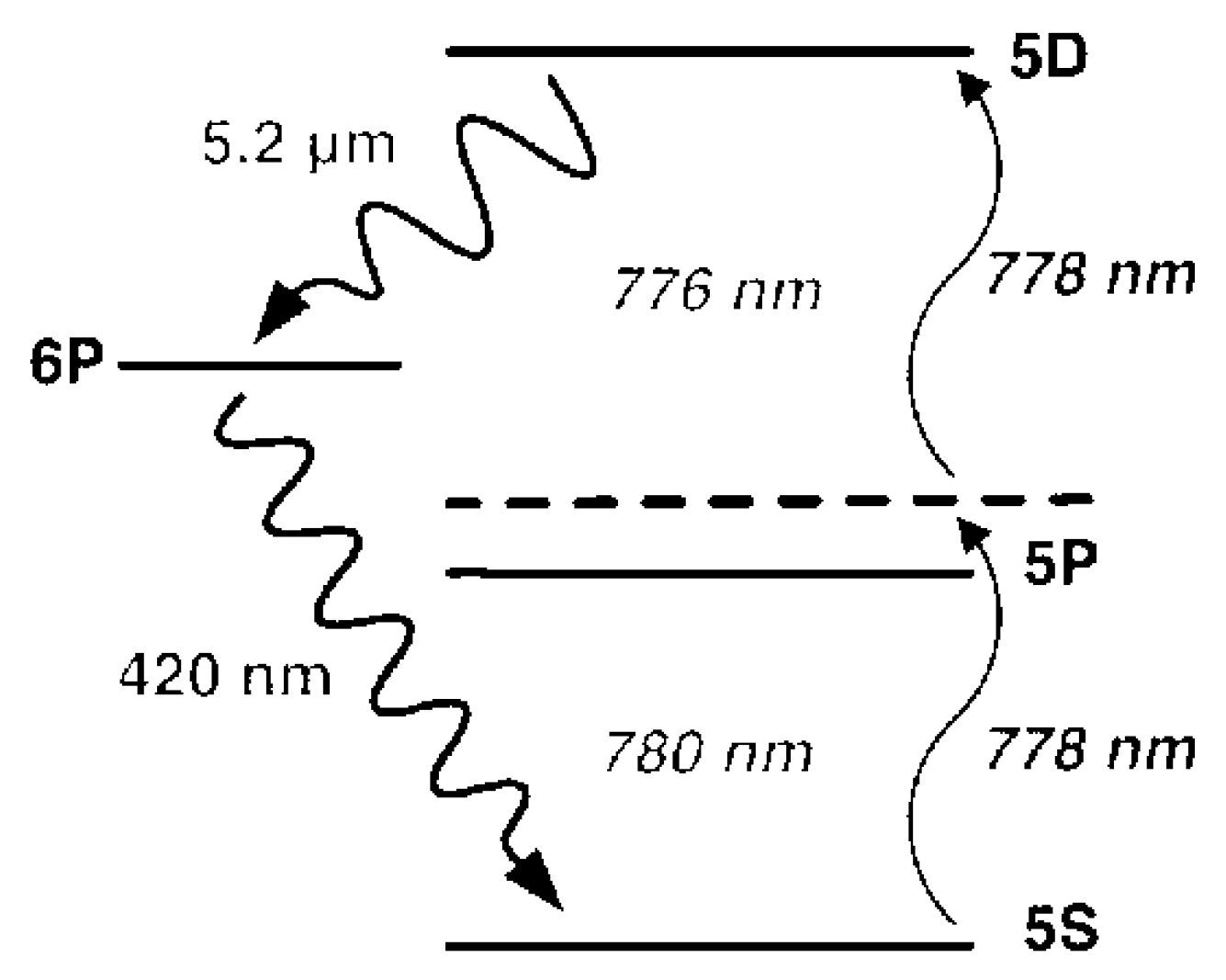
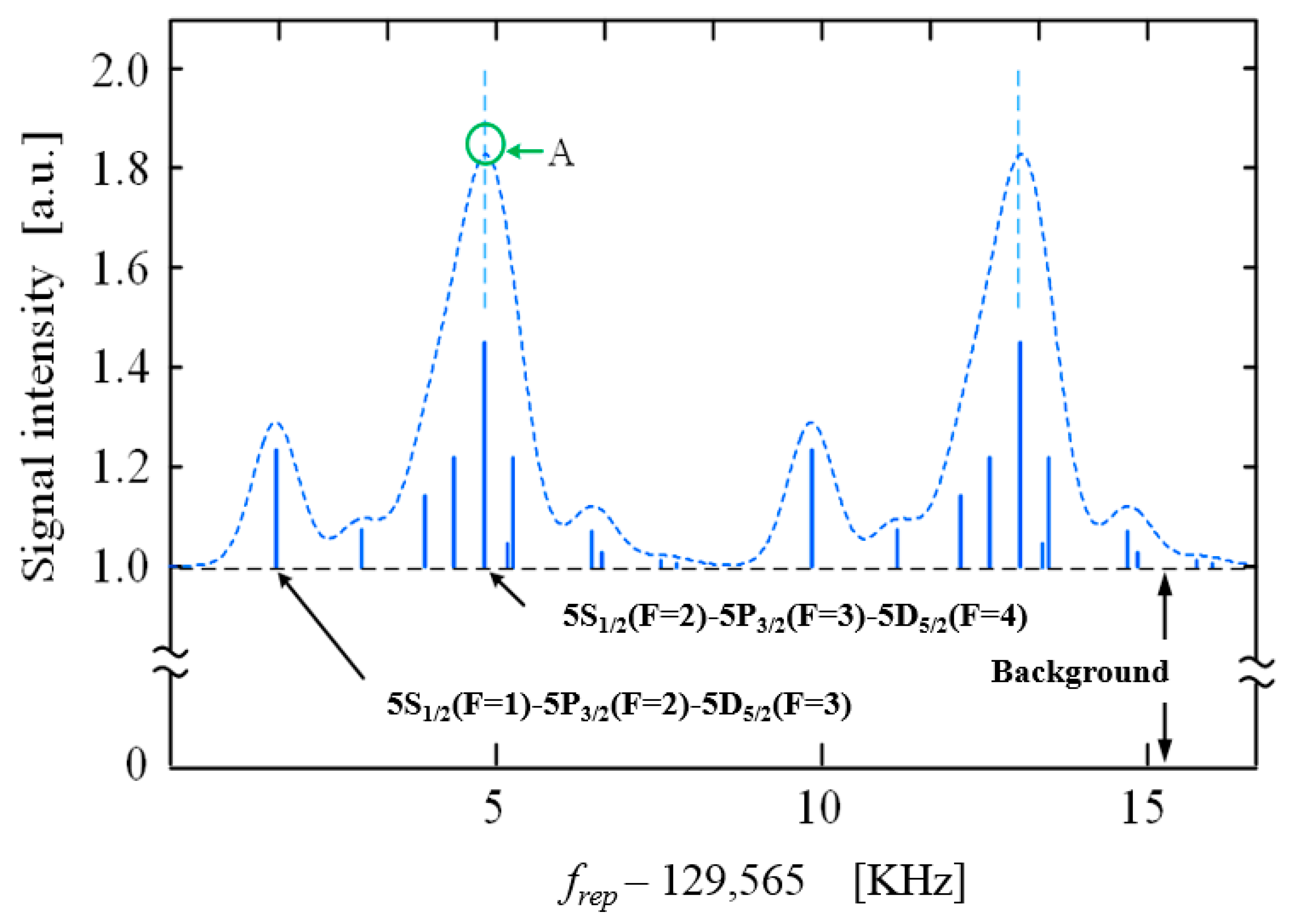

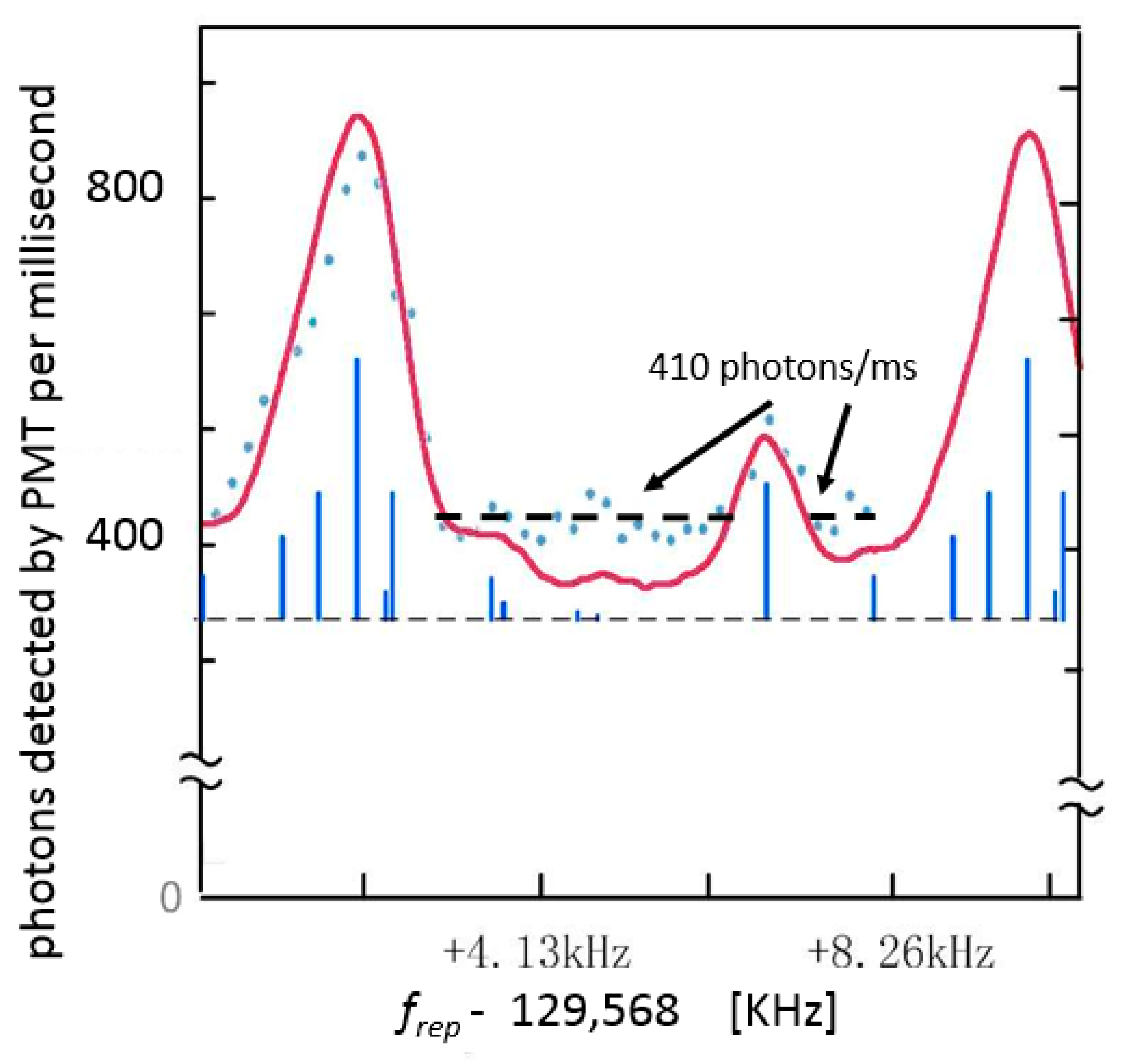
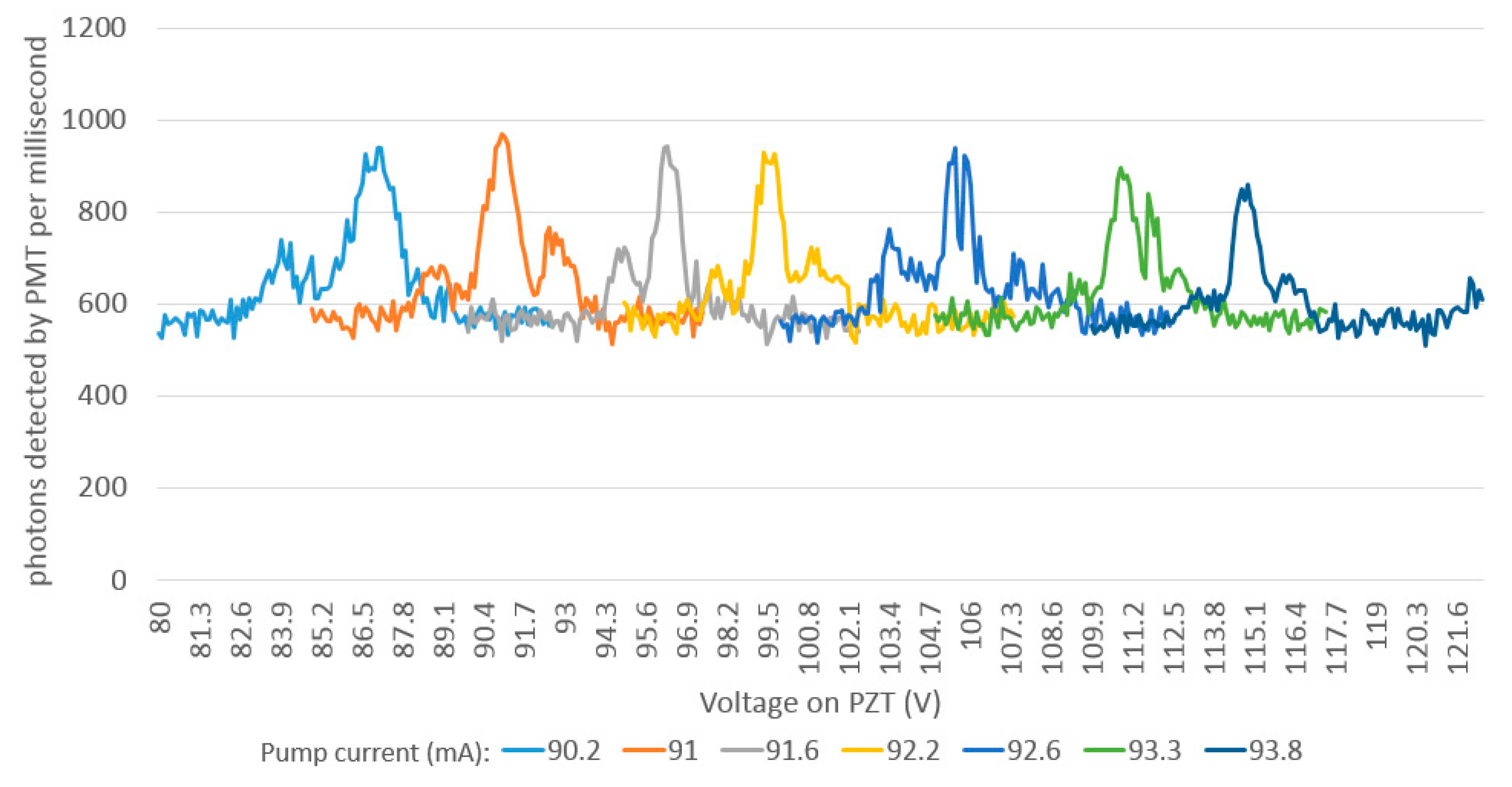
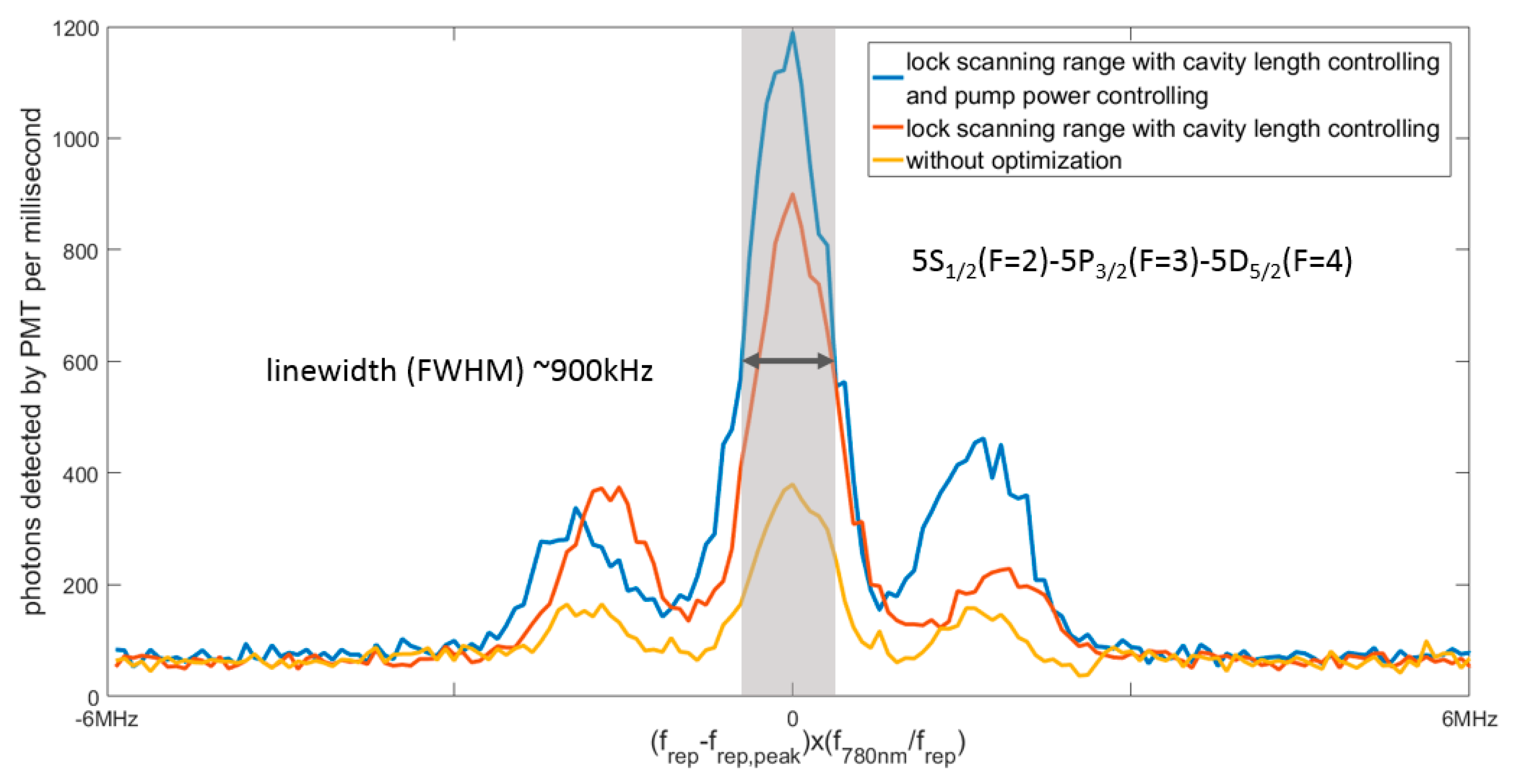
| Rb87 TPT Pathways | Intensity |
|---|---|
| 5S1/2(F = 1)→5P3/2(F = 0)→5D5/2(F = 1) | 0.1666 |
| 5S1/2(F = 1)→5P3/2(F = 1)→5D5/2(F = 1) | 0.125 |
| 5S1/2(F = 1)→5P3/2(F = 1)→5D5/2(F = 2) | 0.2916 |
| 5S1/2(F = 1)→5P3/2(F = 2)→5D5/2(F = 1) | 0.00817 |
| 5S1/2(F = 1)→5P3/2(F = 2)→5D5/2(F = 2) | 0.0972 |
| 5S1/2(F = 1)→5P3/2(F = 2)→5D5/2(F = 3) | 0.3111 |
| 5S1/2(F = 2)→5P3/2(F = 1)→5D5/2(F = 1) | 0.015 |
| 5S1/2(F = 2)→5P3/2(F = 1)→5D5/2(F = 2) | 0.035 |
| 5S1/2(F = 2)→5P3/2(F = 2)→5D5/2(F = 1) | 0.0049 |
| 5S1/2(F = 2)→5P3/2(F = 2)→5D5/2(F = 2) | 0.0583 |
| 5S1/2(F = 2)→5P3/2(F = 2)→5D5/2(F = 3) | 0.1866 |
| 5S1/2(F = 2)→5P3/2(F = 3)→5D5/2(F = 2) | 0.0066 |
| 5S1/2(F = 2)→5P3/2(F = 3)→5D5/2(F = 3) | 0.0933 |
| 5S1/2(F = 2)→5P3/2(F = 3)→5D5/2(F = 4) | 0.5999 |
© 2019 by the authors. Licensee MDPI, Basel, Switzerland. This article is an open access article distributed under the terms and conditions of the Creative Commons Attribution (CC BY) license (http://creativecommons.org/licenses/by/4.0/).
Share and Cite
Lu, H.; Leng, J.; Zhao, J. The Optimization of Cold Rubidium Atom Two-Photon Transition Excitation with an Erbium-Fiber Optical Frequency Comb. Appl. Sci. 2019, 9, 921. https://doi.org/10.3390/app9050921
Lu H, Leng J, Zhao J. The Optimization of Cold Rubidium Atom Two-Photon Transition Excitation with an Erbium-Fiber Optical Frequency Comb. Applied Sciences. 2019; 9(5):921. https://doi.org/10.3390/app9050921
Chicago/Turabian StyleLu, Haoyuan, Jianxiao Leng, and Jianye Zhao. 2019. "The Optimization of Cold Rubidium Atom Two-Photon Transition Excitation with an Erbium-Fiber Optical Frequency Comb" Applied Sciences 9, no. 5: 921. https://doi.org/10.3390/app9050921
APA StyleLu, H., Leng, J., & Zhao, J. (2019). The Optimization of Cold Rubidium Atom Two-Photon Transition Excitation with an Erbium-Fiber Optical Frequency Comb. Applied Sciences, 9(5), 921. https://doi.org/10.3390/app9050921




